Exchange Currency
Romanian leu
The leu (plural lei) is the currency of Romania. It is subdivided into 100 bani (singular: ban). The name of the currency means "lion". On 1 July 2005, Romania underwent a currency reform, switching from the previous leu (ROL) to a new leu (RON). 1 RON is equal to 10,000 ROL.
Romania joined the European Union on 1 January 2007 and it is expected to adopt the euro in 2015.
The currency of Moldova is also called the leu, but is independent of the Romanian leu.
Before 1878 the silver Russian ruble was valued so highly as to drive the native coins out of circulation. Consequently, in 1889, Romania unilaterally joined the Latin Monetary Union and adopted a gold standard. Silver coins were legal tender only up to 50 lei. All taxes and customs dues were to be paid in gold and, owing to the small quantities issued from the Romanian mint, foreign gold coins were current, especially French 20-franc pieces (equal at par to 20 lei), Turkish gold lire (22.70), old Russian imperials (20.60) and British sovereigns (25.22).
Romania left the gold standard in 1914 and the leu's value fell. The exchange rate was pegged at 167.20 lei = 1 U.S. Dollar on February 7, 1929, 135.95 lei on November 5, 1936, 204.29 lei on May 18, 1940, and 187.48 Lei on March 31, 1941. During Romania's World War II alliance with Nazi Germany, the leu was pegged to the Reichsmark at a rate of 49.50 lei = 1 Reichsmark, falling to 59.5 lei in April 1941. During Soviet occupation, the exchange rate was 1 ruble = 100 lei. After the war, the value of the currency fell dramatically.
On August 15, 1947, a revaluation took place, with a new leu replacing the old one at a rate of 20,000 old lei = 1 new leu. This revaluation, called a monetary reform or stabilisation measure (mica stabilizare, marea stabilizare), was carried out by the Communist authorities with absolutely no advance warning and without the possibility to exchange more than a fixed amount of money for the new currency. This was done in order to depose the former middle and upper classes of their last assets, after nationalization, to prepare for collectivization and to finalize the installation of communism. At the time of its introduction, 150 new lei equalled 1 U.S. dollar.
On January 28, 1952, another new leu was introduced. Unlike the previous revaluation, different rates were employed for different kinds of exchange (cash, bank deposits, debts etc.) and different amounts. These rates ranged from 20 to 400 "old lei" for 1 "new" leu. Again, no advance warning was given before the reform took place.
During the communist era, the gold standard was dropped after requiring severe adjustments to prevent inflation following the revaluations. After the gold standard was dropped, the leu lost convertibility and, between 1970 and 1989, the official exchange rate was fixed by the government through law. This exchange rate was used by the government to calculate the value of foreign trade, but foreign currency was not available to be bought and sold by private individuals. Owning or attempting to buy or sell foreign currency was a criminal offence, punishable with a prison sentence that could go up to 10 years (depending on the amount of foreign currency found under one's possession). International trade was therefore considered as part of another economic circuit than domestic trade, and given greater priority. This inflexibility and the existence of surplus money due to constant economic decline in the 1980s, mixed with the need for more foreign currency and the refusal of the Ceauşescu regime to accept inflation as a phenomenon in order to attain convertibility, led to one of the greatest supply side crises in Romanian history, culminating with the introduction of partial food rationing in 1980 and full rationing for all basic foods in 1986/87. This was a major factor in growing discontent with Ceauşescu, and contributed in part to the fall of the Communist regime in 1989.
In the 1990s, after the downfall of communism, inflation ran high due to reform failures, the legalization of owning foreign currency in 1990, and the bankrupt policies of the former communist era, reaching rates as high as 300% per year in 1993. By September 2003, one euro was exchanged for more than 40,000 lei, this being its peak value. Following a number of successful monetary policies in the late 1990s and early 2000s, the situation became gradually more stable, with one digit inflation in 2005.
The Romanian leu was briefly the world's least valued currency unit, from January (when the Turkish lira dropped six zeros) to July 2005. However, the 1,000,000 lei bill was not the highest Romanian denomination ever. This distinction belongs to the 5 million lei bill from 1947.
On 1 July 2005, the leu was revalued at the rate of 10,000 "old" lei (ROL) for one "new" leu (RON), thus psychologically bringing the purchasing power of the leu back in line with those of other major Western currencies. The term chosen for the action was "denominare", similar to the English "denomination", to signify not a conversion, but rather a total reinvention.
The first day brought difficulties adjusting to the new paper currencies and closed ATMs (that needed reprogramming) and forcing a new calculation habit that slowed down shops and annoyed some sales staff and older shoppers. The old ROL currency banknotes remained in circulation until December 31, 2006 (coins remained in circulation only until December 31, 2005), but all accounts have been converted starting July 1, 2005. There is no conversion time limit between the currencies. Retailers had to display prices in both old and new currency from March 1, 2005 until June 30, 2006. The appreciation of the leu during 2005 was about 20% against a basket of major currencies.
As of 2006, the revaluation is a potential source of confusion, especially to visitors, since both old and new currency values are commonly quoted. When written, the very large amounts in old currency are usually obvious, but in speaking inhabitants might refer to an amount of 5 new lei as simply "fifty" in reference to its value of 50,000 old lei.
The euro is expected to replace the leu on 1 January 2015.
In 1900, cupro-nickel 5, 10 and 20 bani coins were introduced, with holed versions following in 1905. The production of coins ceased in 1914, recommencing in 1921 with aluminium 25 and 50 bani pieces. Cupro-nickel 1 and 2 lei coins were introduced in 1924, followed by nickel brass 10, 20 and 50 lei in 1930. In 1932, silver 100 lei coins were issued. However, inflation meant that, in 1935, smaller silver 250 lei coins were introduced with nickel 100 lei coins being issued in 1936, followed by nickel 50 lei in 1937.
In 1941 and 1942, zinc 2, 5 and 20 lei coins were introduced, together with silver 200 and 500 lei. Nickel-clad-steel 100 lei followed in 1943, with brass 200 and 500 lei issued in 1945. In 1946 and 1947, a new coinage was issued consisting of aluminium 500 lei, brass 2000 and 10,000 lei, and silver 25,000 and 100,000 lei.
The production of coins ceased in 1914, recommencing in 1921 with aluminium 25 and 50 bani pieces.
Cupro-nickel 1 and 2 lei coins were introduced in 1924, followed by nickel brass 10, 20 and 50 lei in 1930.
In 1932, silver 100 lei coins were issued. However, inflation meant that, in 1935, smaller silver 250 lei coins were introduced with nickel 100 lei coins being issued in 1936, followed by nickel 50 lei in 1937.
In 1947, coins were issued before the overthrow of King Michael I, in denominations of 50 bani, 1, 2 and 5 lei. After the creation of the People's Republic, new coins were issued between 1948 and 1952, in denominations of 1, 2, 5 and 20 lei.
In 1952, coins were introduced in denominations of 1, 3, 5, 10 and 25 bani, with the 1, 3 and 5 struck in aluminium bronze and the others in cupro-nickel. In 1955, cupro-nickel 50 bani were added.
In 1960, a new coinage was introduced, consisting of 15 and 25 bani, with 5 bani, 1 and 3 lei coins added in 1963. All were struck in nickel-clad steel. In 1975, aluminium replaced steel in the 5 and 15 bani, with the same change happening for the 25 bani in 1982. Aluminium 5 lei were introduced in 1978.
Following the end of the communist regime, a new coinage was introduced between 1990 and 1992, consisting of 1 leu in bronze clad steel, 5 and 10 lei in nickel plated steel, 20 and 50 lei in brass clad steel and nickel plated steel 100 lei.
As inflation took its toll, 500, 1000 and 5000 lei coins were introduced in 1999, 2000 and 2001, respectively, and were the only coins circulating when the revaluation occurred. They were all criticized for being clumsy and difficult to use. The 500 lei coins were very thick (about 0.3 cm). Despite their small value, it took only a handful of such coins to fill one's pocket. They were also made of poor material and could be occasionally found with bite marks. The 1000 lei coin was considered too small and was also cheaply made, and the 5000 lei coin was not circular (it was a dodecagon). This made it awkward to handle and difficult to use in slot machines, where it was frequently the only coin accepted. The 500, 1000 and 5000 lei coins became worth 5, 10 and 50 bani with the revaluation.
The 1 ban coin is rare and not in demand by either banks or retailers. In practice, retailers almost always round to the nearest 5 bani and recently to 10 bani.
In 1914, 5 lei notes were introduced, followed by 1 and 2 lei notes in 1915 and 500 lei in 1916. The Ministry of Finance issued very small sized notes for 10, 25 and 50 bani in 1917. 500 lei notes were introduced in 1940, followed by 10,000 and 100,000 lei in 1945 and 1 and 5 million lei in 1947. In 1945, the Ministry of Finance issued 20 and 100 lei notes to replace those of the National Bank's.
In 1947, the Ministry of Finance introduced 20 lei notes and Banca Naţională a României introduced 100, 500 and 1000 lei notes. In 1949, Banca Republicii Populare Române took over the production of paper money and issued 500 and 1000 lei notes.
In 1952, the Ministry of Finance introduced notes for 1, 3 and 5 lei, and the Banca Republicii Populare Române introduced 10, 25 and 100 lei notes. In 1966, the Banca Națională a Republicii Socialiste România took over the production of all paper money, issuing notes for 1, 3, 5, 10, 25, 50 and 100 lei.
In 1991, 500 and 1000 lei notes were introduced, followed by 200 and 5000 lei notes in 1992, 10,000 lei in 1994, 50,000 lei in 1996, 100,000 lei in 1998, 500,000 lei in 2000 and 1 million lei in 2003. There was also a 2,000 lei note introduced in 1999; it celebrated the total solar eclipse that occurred on August 11, 1999. The final issues of the 2000, 10,000, 50,000, 100,000, 500,000 and 1 million lei were polymer notes.
In 2005, polymer notes were introduced for 1, 5, 10, 50, 100 and 500 lei. 200 lei notes were added in 2006. The designs of the 1, 5, 10, 50 and 100 lei notes are based on those of the earlier 10,000, 50,000, 100,000, 500,000 and 1 million lei notes which they replaced. The 10 lei bill was redesigned in November 2008 (most of the graphic elements are identical, some of the safety elements were changed, making its safety features similar to the lower values of 1 leu and 5 lei notes).
The currency of Moldova is also called the leu, but is independent of the Romanian leu.
Summary info
Summary information about Romanian leu- ISO 4217 Code:
- RON
- Currency sign:
- Country:
- Romania
- Subunit:
- ban
- Coins:
- 1 ban, 5 bani, 10 bani, 50 bani
- Banknotes:
- 1 leu, 5 lei, 10 lei, 50 lei, 100 lei, 200 lei, 500 lei
- Central bank:
- National Bank of Romania
History
On April 22, 1867, a bimetallic currency was adopted, with the leu equal to 5 grams of 83.5% silver or 0.29032 grams of gold.Before 1878 the silver Russian ruble was valued so highly as to drive the native coins out of circulation. Consequently, in 1889, Romania unilaterally joined the Latin Monetary Union and adopted a gold standard. Silver coins were legal tender only up to 50 lei. All taxes and customs dues were to be paid in gold and, owing to the small quantities issued from the Romanian mint, foreign gold coins were current, especially French 20-franc pieces (equal at par to 20 lei), Turkish gold lire (22.70), old Russian imperials (20.60) and British sovereigns (25.22).
Romania left the gold standard in 1914 and the leu's value fell. The exchange rate was pegged at 167.20 lei = 1 U.S. Dollar on February 7, 1929, 135.95 lei on November 5, 1936, 204.29 lei on May 18, 1940, and 187.48 Lei on March 31, 1941. During Romania's World War II alliance with Nazi Germany, the leu was pegged to the Reichsmark at a rate of 49.50 lei = 1 Reichsmark, falling to 59.5 lei in April 1941. During Soviet occupation, the exchange rate was 1 ruble = 100 lei. After the war, the value of the currency fell dramatically.
On August 15, 1947, a revaluation took place, with a new leu replacing the old one at a rate of 20,000 old lei = 1 new leu. This revaluation, called a monetary reform or stabilisation measure (mica stabilizare, marea stabilizare), was carried out by the Communist authorities with absolutely no advance warning and without the possibility to exchange more than a fixed amount of money for the new currency. This was done in order to depose the former middle and upper classes of their last assets, after nationalization, to prepare for collectivization and to finalize the installation of communism. At the time of its introduction, 150 new lei equalled 1 U.S. dollar.
On January 28, 1952, another new leu was introduced. Unlike the previous revaluation, different rates were employed for different kinds of exchange (cash, bank deposits, debts etc.) and different amounts. These rates ranged from 20 to 400 "old lei" for 1 "new" leu. Again, no advance warning was given before the reform took place.
During the communist era, the gold standard was dropped after requiring severe adjustments to prevent inflation following the revaluations. After the gold standard was dropped, the leu lost convertibility and, between 1970 and 1989, the official exchange rate was fixed by the government through law. This exchange rate was used by the government to calculate the value of foreign trade, but foreign currency was not available to be bought and sold by private individuals. Owning or attempting to buy or sell foreign currency was a criminal offence, punishable with a prison sentence that could go up to 10 years (depending on the amount of foreign currency found under one's possession). International trade was therefore considered as part of another economic circuit than domestic trade, and given greater priority. This inflexibility and the existence of surplus money due to constant economic decline in the 1980s, mixed with the need for more foreign currency and the refusal of the Ceauşescu regime to accept inflation as a phenomenon in order to attain convertibility, led to one of the greatest supply side crises in Romanian history, culminating with the introduction of partial food rationing in 1980 and full rationing for all basic foods in 1986/87. This was a major factor in growing discontent with Ceauşescu, and contributed in part to the fall of the Communist regime in 1989.
In the 1990s, after the downfall of communism, inflation ran high due to reform failures, the legalization of owning foreign currency in 1990, and the bankrupt policies of the former communist era, reaching rates as high as 300% per year in 1993. By September 2003, one euro was exchanged for more than 40,000 lei, this being its peak value. Following a number of successful monetary policies in the late 1990s and early 2000s, the situation became gradually more stable, with one digit inflation in 2005.
The Romanian leu was briefly the world's least valued currency unit, from January (when the Turkish lira dropped six zeros) to July 2005. However, the 1,000,000 lei bill was not the highest Romanian denomination ever. This distinction belongs to the 5 million lei bill from 1947.
On 1 July 2005, the leu was revalued at the rate of 10,000 "old" lei (ROL) for one "new" leu (RON), thus psychologically bringing the purchasing power of the leu back in line with those of other major Western currencies. The term chosen for the action was "denominare", similar to the English "denomination", to signify not a conversion, but rather a total reinvention.
The first day brought difficulties adjusting to the new paper currencies and closed ATMs (that needed reprogramming) and forcing a new calculation habit that slowed down shops and annoyed some sales staff and older shoppers. The old ROL currency banknotes remained in circulation until December 31, 2006 (coins remained in circulation only until December 31, 2005), but all accounts have been converted starting July 1, 2005. There is no conversion time limit between the currencies. Retailers had to display prices in both old and new currency from March 1, 2005 until June 30, 2006. The appreciation of the leu during 2005 was about 20% against a basket of major currencies.
As of 2006, the revaluation is a potential source of confusion, especially to visitors, since both old and new currency values are commonly quoted. When written, the very large amounts in old currency are usually obvious, but in speaking inhabitants might refer to an amount of 5 new lei as simply "fifty" in reference to its value of 50,000 old lei.
The euro is expected to replace the leu on 1 January 2015.
Coins
In 1867, copper 1, 2, 5 and 10 bani were issued, with gold 20 lei (known as poli after the French Napoleons) first minted the next year. These were followed, between 1870 and 1873, by silver 50 bani, 1 and 2 lei. Silver 5 lei were added in 1880. Uniquely, the 1867 issue used the denomination 1 banu rather than 1 ban.In 1900, cupro-nickel 5, 10 and 20 bani coins were introduced, with holed versions following in 1905. The production of coins ceased in 1914, recommencing in 1921 with aluminium 25 and 50 bani pieces. Cupro-nickel 1 and 2 lei coins were introduced in 1924, followed by nickel brass 10, 20 and 50 lei in 1930. In 1932, silver 100 lei coins were issued. However, inflation meant that, in 1935, smaller silver 250 lei coins were introduced with nickel 100 lei coins being issued in 1936, followed by nickel 50 lei in 1937.
In 1941 and 1942, zinc 2, 5 and 20 lei coins were introduced, together with silver 200 and 500 lei. Nickel-clad-steel 100 lei followed in 1943, with brass 200 and 500 lei issued in 1945. In 1946 and 1947, a new coinage was issued consisting of aluminium 500 lei, brass 2000 and 10,000 lei, and silver 25,000 and 100,000 lei.
The production of coins ceased in 1914, recommencing in 1921 with aluminium 25 and 50 bani pieces.
Cupro-nickel 1 and 2 lei coins were introduced in 1924, followed by nickel brass 10, 20 and 50 lei in 1930.
In 1932, silver 100 lei coins were issued. However, inflation meant that, in 1935, smaller silver 250 lei coins were introduced with nickel 100 lei coins being issued in 1936, followed by nickel 50 lei in 1937.
In 1947, coins were issued before the overthrow of King Michael I, in denominations of 50 bani, 1, 2 and 5 lei. After the creation of the People's Republic, new coins were issued between 1948 and 1952, in denominations of 1, 2, 5 and 20 lei.
In 1952, coins were introduced in denominations of 1, 3, 5, 10 and 25 bani, with the 1, 3 and 5 struck in aluminium bronze and the others in cupro-nickel. In 1955, cupro-nickel 50 bani were added.
In 1960, a new coinage was introduced, consisting of 15 and 25 bani, with 5 bani, 1 and 3 lei coins added in 1963. All were struck in nickel-clad steel. In 1975, aluminium replaced steel in the 5 and 15 bani, with the same change happening for the 25 bani in 1982. Aluminium 5 lei were introduced in 1978.
Following the end of the communist regime, a new coinage was introduced between 1990 and 1992, consisting of 1 leu in bronze clad steel, 5 and 10 lei in nickel plated steel, 20 and 50 lei in brass clad steel and nickel plated steel 100 lei.
As inflation took its toll, 500, 1000 and 5000 lei coins were introduced in 1999, 2000 and 2001, respectively, and were the only coins circulating when the revaluation occurred. They were all criticized for being clumsy and difficult to use. The 500 lei coins were very thick (about 0.3 cm). Despite their small value, it took only a handful of such coins to fill one's pocket. They were also made of poor material and could be occasionally found with bite marks. The 1000 lei coin was considered too small and was also cheaply made, and the 5000 lei coin was not circular (it was a dodecagon). This made it awkward to handle and difficult to use in slot machines, where it was frequently the only coin accepted. The 500, 1000 and 5000 lei coins became worth 5, 10 and 50 bani with the revaluation.
The 1 ban coin is rare and not in demand by either banks or retailers. In practice, retailers almost always round to the nearest 5 bani and recently to 10 bani.
Banknotes
In 1877, state notes were introduced in denominations of 5, 10, 20, 50, 100 and 500 lei. In 1880, these notes were overstamped for issue by the Banca Națională a României, which began to issue regular notes in 1881 in denominations of 20, 100 and 1000 lei.In 1914, 5 lei notes were introduced, followed by 1 and 2 lei notes in 1915 and 500 lei in 1916. The Ministry of Finance issued very small sized notes for 10, 25 and 50 bani in 1917. 500 lei notes were introduced in 1940, followed by 10,000 and 100,000 lei in 1945 and 1 and 5 million lei in 1947. In 1945, the Ministry of Finance issued 20 and 100 lei notes to replace those of the National Bank's.
In 1947, the Ministry of Finance introduced 20 lei notes and Banca Naţională a României introduced 100, 500 and 1000 lei notes. In 1949, Banca Republicii Populare Române took over the production of paper money and issued 500 and 1000 lei notes.
In 1952, the Ministry of Finance introduced notes for 1, 3 and 5 lei, and the Banca Republicii Populare Române introduced 10, 25 and 100 lei notes. In 1966, the Banca Națională a Republicii Socialiste România took over the production of all paper money, issuing notes for 1, 3, 5, 10, 25, 50 and 100 lei.
In 1991, 500 and 1000 lei notes were introduced, followed by 200 and 5000 lei notes in 1992, 10,000 lei in 1994, 50,000 lei in 1996, 100,000 lei in 1998, 500,000 lei in 2000 and 1 million lei in 2003. There was also a 2,000 lei note introduced in 1999; it celebrated the total solar eclipse that occurred on August 11, 1999. The final issues of the 2000, 10,000, 50,000, 100,000, 500,000 and 1 million lei were polymer notes.
In 2005, polymer notes were introduced for 1, 5, 10, 50, 100 and 500 lei. 200 lei notes were added in 2006. The designs of the 1, 5, 10, 50 and 100 lei notes are based on those of the earlier 10,000, 50,000, 100,000, 500,000 and 1 million lei notes which they replaced. The 10 lei bill was redesigned in November 2008 (most of the graphic elements are identical, some of the safety elements were changed, making its safety features similar to the lower values of 1 leu and 5 lei notes).
RON banknotes pictures gallery
| 1 Romanian leu | |
|---|---|
| Banknote of 1 Romanian leu has dimensions 120×62 mm and main colors are pale spring bud, asparagus, sand, medium spring bud, beige, tea green and isabelline. The banknote of 1 Romanian leu was issued on the 1 July 2005. | |
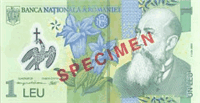 Obverse side of the 1 Romanian leu is showing the portrait of Nicolae Iorga (17 January 1871 – 27 November 1940) and Willow Gentian (Gentiana asclepiadea) flowers. |
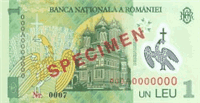 Reverse side of the 1 Romanian leu is showing the Episcopal Cathedral of Curtea de Arges monastery erected by Neagoe Basarab (1512-1521) and stylised crusader eagle as Wallachian Coat of Arms of Prince Constantin Brancoveanu. |
| 5 Romanian lei | |
|---|---|
| Banknote of 5 Romanian lei has dimensions 127×67 mm and main colors are rose quartz, thistle, lilac, tea rose, pearl, pastel gray and lavender mist. The banknote of 5 Romanian leu was issued on the 1 July 2005. | |
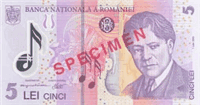 Obverse side of the 5 Romanian lei is showing the portrait of the composer George Enescu (1881 - 1955), carnation flower (Dianthus dianthus), musical notes and violin. |
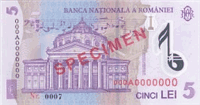 Reverse side of the 5 Romanian lei is showing the "Romanian Athenaeum" concert hall in Bucharest, a fragment of musical chord (notes, score, notation) from Enescu's opera "King Oedipus" (Œdipus Rex) and Fortepiano (grand piano, musician's piano). |
| 10 Romanian lei | |
|---|---|
| Banknote of 10 Romanian lei has dimensions 133×72 mm and main colors are pale chestnut, pale pink, thistle, pastel brown, dark electric blue, timberwolf and pale aqua. The banknote of 10 Romanian leu was issued on the 1 July 2005. | |
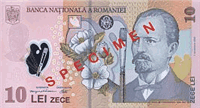 Obverse side of the 10 Romanian lei is showing the portrait of Nicolae Grigorescu (1838 - 1907), Romanian painter, the Marsh Mallow Hollyhock flower (Althaea officinalis) and artist's palette and paintbrush. |
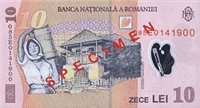 Reverse side of the 10 Romanian lei is showing a House from Oltenia region, Nicolae Grigorescu painting "Rodica", representing a country girl. |
| 50 Romanian lei | |
|---|---|
| Banknote of 50 Romanian lei has dimensions 140×77 mm and main colors are puce, light yellow, lemon chiffon, pale goldenrod, cambridge blue, manatee, desert sand, flavescent and khaki. The banknote of 50 Romanian leu was issued on the 1 July 2005. | |
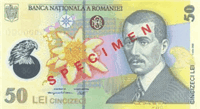 Obverse side of the 50 Romanian lei is showing the portrait of Aurel Vlaicu (1882 - 1913), Romanian engineer, inventor, pilot and airplane builder, head of a mountain eagle, the Edelweiss flower (Leontopodium alpinum) and a stylised airplane propeller. |
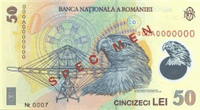 Reverse side of the 50 Romanian lei is showing the Head of Mountain Eagle (Aquila chrysaetos), "Vlaicu II" airplane design and "Gnome" engine sketch. |
| 100 Romanian lei | |
|---|---|
| Banknote of 100 Romanian lei has dimensions 147×82 mm and main colors are cool grey, ucla blue, lavender mist, moonstone blue, medium spring bud, khaki, pale aqua, aurometalsaurus and silver. The banknote of 100 Romanian leu was issued on the 1 July 2005. | |
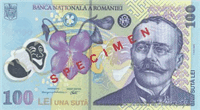 Obverse side of the 100 Romanian lei is showing the portrait of Ion Luca Caragiale (1852 - 1912), Romanian playwright, author and short-story writer, the Violet (Viola sororia) flower, a theatre mask and the comedy mask. |
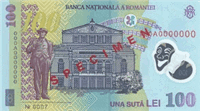 Reverse side of the 100 Romanian lei is showing the Old building of the National Theatre in Bucharest where Caragiale was a General Director and the Statue of the playwright Caragiale. |
| 200 Romanian lei | |
|---|---|
| Banknote of 200 Romanian lei has dimensions 150×82 mm and main colors are umber, rifle green, pale spring bud, burlywood, rose gold, chamoisee, outer space, liver, pale spring bud and pearl. The banknote of 200 Romanian leu was issued on the 1 December 2006. | |
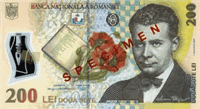 Obverse side of the 200 Romanian lei is showing the portrait of Lucian Blaga (May 9, 1895 – May 6, 1961). He was a philosopher and writer highly acclaimed for his originality, a university professor and a diplomat. Also, on the banknote is showing the poppies. |
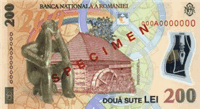 Reverse side of the 200 Romanian lei is showing a water mill and the Hamangia Thinker. |
| 500 Romanian lei | |
|---|---|
| Banknote of 500 Romanian lei has dimensions 153×82 mm and main colors are pale aqua, dim gray, gainsboro, tea green, isabelline, platinum and taupe gray. The banknote of 500 Romanian leu was issued in 2005. | |
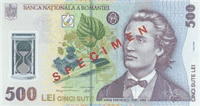 Obverse side of the 500 Romanian lei is showing the portrait of Mihai Eminescu (January 15, 1850 – June 15, 1889). He was a Romantic poet, novelist and journalist, often regarded as the most famous and influential Romanian poet. |
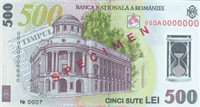 Reverse side of the 500 Romanian lei is showing the Central University Library of Iaşi. |
Useful links
- About National Bank of Romania:
- National Bank of Romania
- List of currencies:
- Currencies
- Security and design features of RON banknotes:
- RON banknotes
- RON currency on Wikipedia:
- Romanian leu
- Official Website of National Bank of Romania:
- www.bnr.ro
- Commemorative coins:
- Commemorative Coins